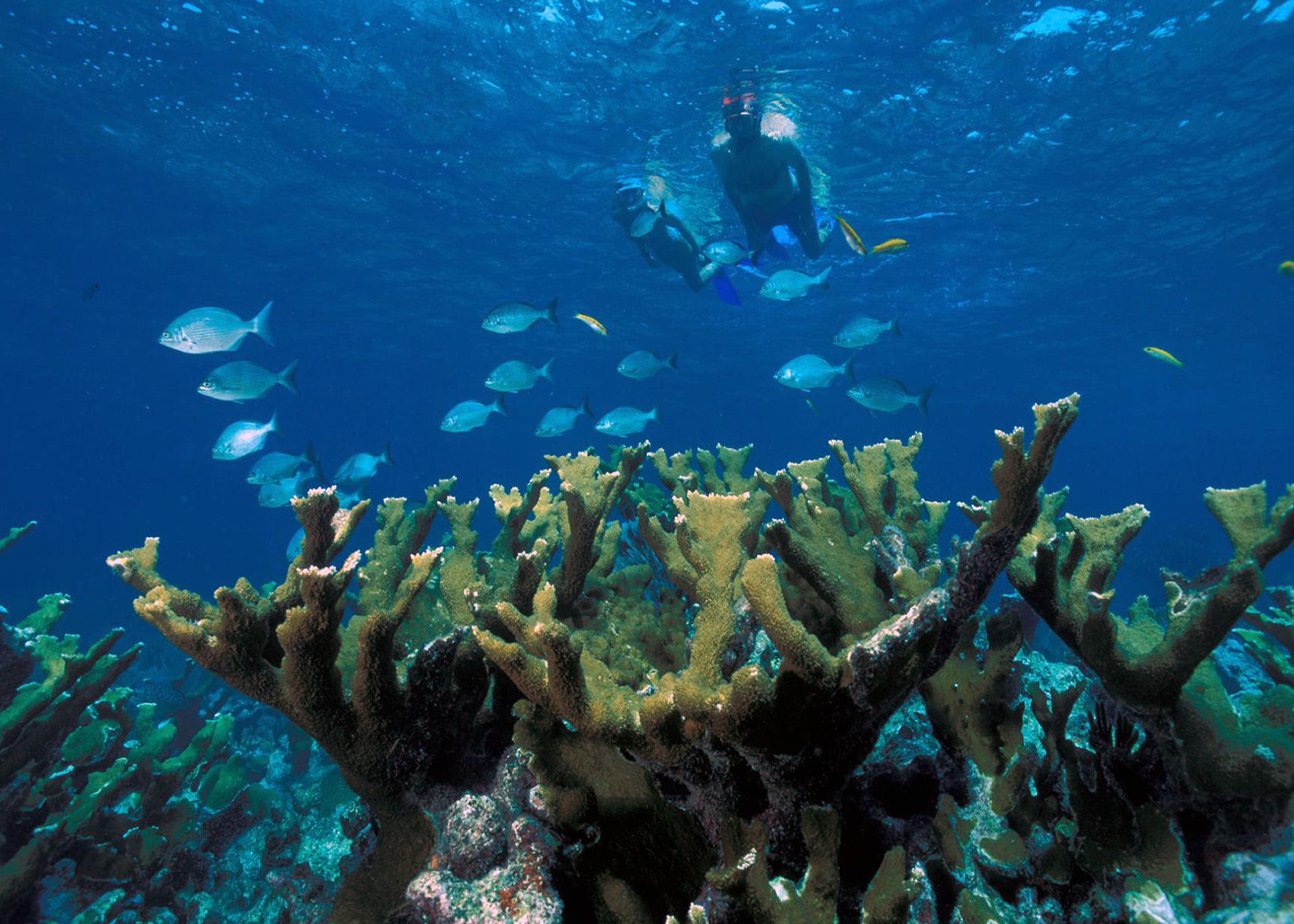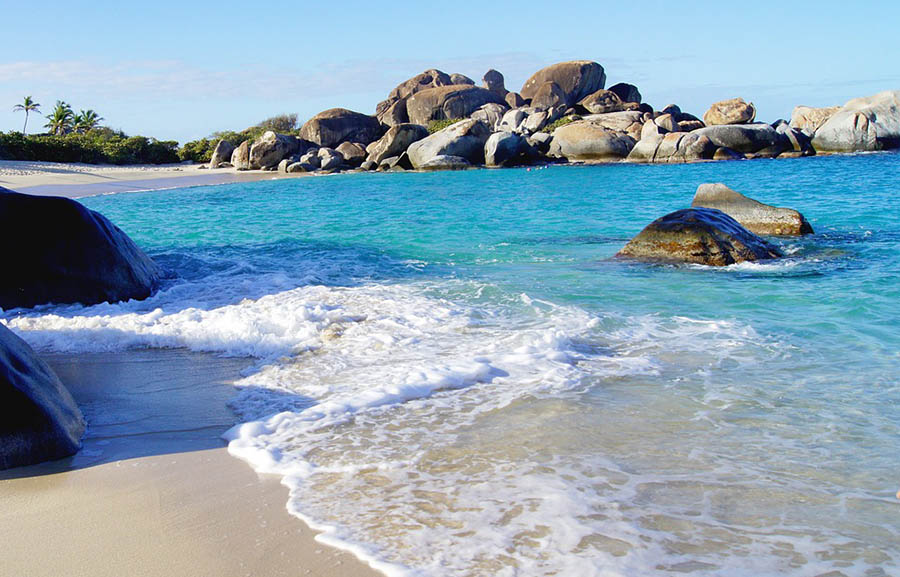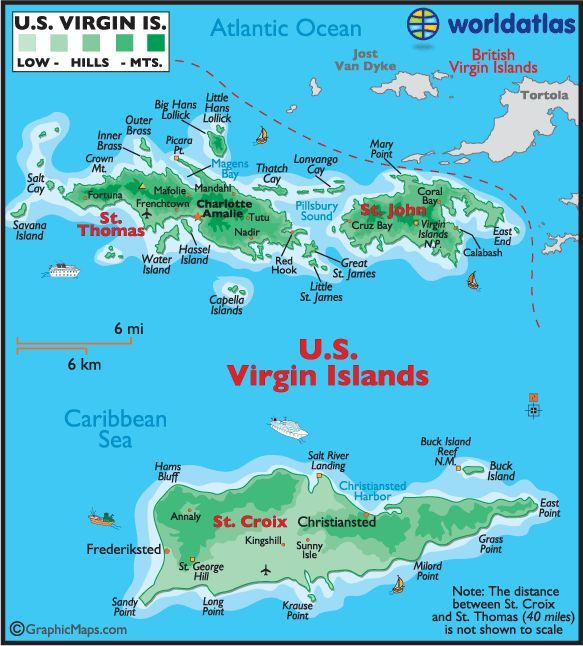
Updated May 13, 2023
This is the thirty-eighth in a series of reviews of the best scuba diving destinations around the world. In this post, the focus is on the U.S. Virgin Islands.
In addition to this series on dive resort locations, the best worldwide liveaboard dive locations and services are reviewed in their own series. To check them out, or others in this series, click on Liveaboards / Resorts on the menu at the top and choose a title from the list.
Have you ever been diving in the US Virgin Islands? If so, I’d love to know about your experience. What dive shop or liveaboard did you use? Which dive spots are the best and what are the conditions there regarding the visibility, current, water temperature, sealife attractions, etc.? Please post your response in the comments section at the bottom and we’ll all learn something we can use.
Best Scuba Diving in the US Virgin Islands
Background
Situated 40 miles (60 kilometers) east of Puerto Rico and just west of the British Virgin Islands are the US Virgin Islands of St. Croix, St. Thomas, St. James, and many small islands.
Sold by Denmark to the US in 1916, this US territory has a population of over 105,000 on 134 square miles (346 kilometers) of land.
St. Thomas and St. James are volcanic in origin and hilly while St. Croix which resulted from coral reefs is flatter. They are known for white sandy beaches and deep water harbors suitable for the cruise liners which arrive daily.
The local mostly Afro-Caribbean population relies on an economy dominated by tourism with minor input from the rum industry and farming.


Undersea World
Each island has its own special character. St. Croix, separated from the others by 40 miles (60 kilometers) has more than 50 sites, with 6 shipwrecks and Frederiksted Pier, famous for macro critters. St. Thomas is where the cruise liners dock and has leatherback turtle nesting beaches. St. John has more than 25 sites nearby and is known for fringing reefs, shallow coral gardens, and steep walls with lots of reef fish.
Featured Sea Life includes this list of attractions: tunicates, anemones, octopus, crabs, a variety of shrimps, spiny lobster, various mollusks, cleaner gobies, seahorses, frogfish, nudibranchs, scorpionfish, blackbar soldierfish, blue tangs, trumpetfish, moray eels, grouper, horse-eye jacks, queen triggerfish, Creole wrasses, southern stingrays, eagle rays, nurse and Caribbean reef sharks, barracuda, tarpon, snappers, green, hawksbill and leatherback turtles, and dolphins.
Seasons and Conditions
Diving is great year-round with average air temperature ranging from 79-83°F (26-29°C).
Water temperature also does not vary much seasonally with lows of 79°F (26°C) from January to April, and highs of 84°F (29°C) in September and October.
It rains throughout the year with a bit more from September through January. June through October is the hurricane season, which occasionally disrupts things.
Visibility is quite good at its usual 60-100 feet (18-30 meters).
Most dive sites do not have a strong current, but some are known for it. Available conditions and dive sites are suitable for all skill levels.
There are scuba diving courses for absolute beginners, most specialties, like wreck diving and drift diving, and more advanced levels at local dive centers.
I have a close friend who doesn’t want to take up scuba diving but does go to these islands annually for snorkeling. He tells me he has found excellent sites on all of them that are easily accessible.
Liveaboard Diving
The U.S. Virgin Islands is not an area renowned for liveaboard diving, but there are many cruises in other areas around the Caribbean including the British Virgin Islands. Click here for details of a British Virgin Islands Liveaboard holiday.
For reviews of diving in other Caribbean locations, please click on these posts:
- Scuba Diving the British Virgin Islands Liveaboard
- Scuba Diving the BVI (British Virgin Islands)
- Scuba Diving in Islamorada Florida
- Scuba Diving on Key West Florida
- Best Scuba Diving Key Largo Florida
- Scuba Diving West Palm Beach Florida
- Ft. Lauderdale Scuba Diving
- Scuba Diving St. Barts
- Scuba Diving St. Eustatius
- Scuba Diving in Saba
- Scuba Diving St Kitts and Nevis
- Best Scuba Diving St. Martin
- Scuba Diving Ambergris Caye Belize
- Best Guadeloupe Scuba Diving
- Anguilla Scuba Diving
- Scuba Diving in Antigua and Barbuda
- Best Scuba Diving Jamaica
- Scuba Diving Cuba Best Dive Sites Cuba
- Best Cuba Scuba Diving Liveaboard Jardines de la Reina
- Scuba Diving the Dominican Republic
- Best Scuba Diving Panama
- Banco Chinchorro Diving Mexico
- Scuba Diving Playa Del Carmen
- Scuba Diving Tulum Mexico
- Cozumel Scuba Diving Review
- Scuba Diving Cancun Mexico
- Best Scuba Diving Puerto Rico
- Scuba Diving St Vincent and the Grenadines Review
- St. Lucia Scuba Diving Review
- Turks and Caicos Scuba Diving Review
- Best Trinidad and Tobago Vacations Scuba Diving
- Best Caribbean Beach Vacations Curacao Scuba Diving
- Best Caribbean Diving Destinations Aruba
- Best Caribbean Dive Vacations Bonaire
- Best Tropical Island Vacations Dominica Scuba Diving
- Best Caribbean Scuba Diving Los Roques Venezuela
- Barbados Scuba Dive Vacations
- Grenada Scuba Diving Review
- Best Scuba Diving Caribbean – Martinique
- Best Bahamas Liveaboard Scuba Vacations
- Best Belize Dive Trips & Cocos Island Diving

A Selection from the Best US Virgin Islands Scuba Diving Sites
Frederiksted Pier, St. Croix – 25-50 feet (8-15 meters), great macro photography site and for night dives, seahorses, frogfish, roughback batfish, golden-eyed shrimp, parrotfish, smooth trunkfish, spotted scorpionfish, lobsters, eels, turtles, schools of baitfish, all levels
Carvel Rock, St. John: 80 feet (24 meters), rock formation breaking the surface, coral garden in the shallows, lots of sponges, sea fans and corals, can execute as a drift dive, “The Cut” is a shallow passage through the rock that can be navigated, tarpon, stingrays, silversides, squid, octopus, nurse sharks, experienced level
Cow and Calf Rocks, St. Thomas – 45 feet (13 meters), named for the shape, arches, swim-throughs, canyons, caverns, rich encrusting life, staghorn corals, silversides, grey reef sharks, a 45-minute boat ride from Charlotte Amalie, beginner level
Cartanser Senior, St. Thomas – 50 feet (15 meters), 190 foot (57-meter) freighter, abandoned and sunk, raised and resunk as a reef near Buck Island in 1979, on the port side in several pieces, yellowtails, groupers, tangs, angelfish, beginner level
Salt River Canyon East and West Walls, St. Croix – from 30 feet (9 meters) down to 1,000 feet (300 meters), walls, small canyons, pinnacles, swim-throughs with lots of corals, gorgonians and sponges, parrotfish, grouper, soldierfish, horse-eye jacks, experienced level
Eagle Shoals, St. John – shoals between Ram Head and Leduck Island, with arches, overhangs, tunnels and caves, one called “The Cathedral,” colorful sponges and corals, black durgons, porkfish, angelfish, silversides, surface conditions can be rough, experienced level
Butler Bay Wrecks, St. Croix – on the east side of St. Croix with shallow and deep wrecks including Rosa Maria – 177-foot (53-meter) freighter, Coakley Bay – oil refinery tugboat, Suffolk Maid – 144-foot (43-meter) trawler, Virgin Islander – 300-foot (90-meter) oil barge, North Wind – 75-foot (22-meter) oil barge, all well encrusted with corals and sponges, with a variety of reef fish including soldierfish, snappers, angelfish, moray eels, stingrays, fairy basslets, chromis, various macroinvertebrates, sites for all levels
US Virgin Islands Photos
With the macro life, wrecks, sharks, rays, pelagics, dolphins, clear water, a beautiful, diverse coral reef, lots of fish, and beautiful onshore targets, there are many excellent photo opportunities. For information and reviews of dive cameras, click here:
US Virgin Islands Transportation, Lodging, and Diving Services
Transportation
There are many regular flights from the US mainland and Puerto Rico to the Cyril E. King Airport on St. Thomas and Henry E. Rohlsen Airport on St. Croix. Taxi and rental cars are readily available. All the islands have a bus service that is not frequent or reliable enough to count on. Ferry service runs between the islands with very frequent service between St. Thomas and St. John which are quite close to each other. St. Croix is 40 miles (60 kilometers) from the other two.
Lodging and Diving
There are quite a few hotels and accommodations from $90 to over $900 per night. Several resorts have in-house dive shops. Otherwise, there are dozens of separate dive operations that provide a full range of services including courses, equipment rental, cruises, and dive guiding.
This website is a good source for the available options and can arrange a booking:
US Virgin Islands Attractions (aside from scuba diving)
Aside from scuba diving, snorkeling, seaside activities and beaches, and the shopping, restaurants, and nightlife, the US Virgin Islands have many exceptional activities to enjoy. Here is a listing of some of the highlights: Virgin Islands National Park, Coral World Ocean Park, Blackbeard’s Castle, Skyride to Paradise Point, Fort Christian, St. Thomas Synagogue, Salt River Bay National Historical Park and Ecological Preserve, 99 Steps, Reef Bay Trail, Drake’s Seat (historic views), St. George Village Botanical Garden, Fort Christiansvaern, Fort Frederik, Chocolate Hole, Tree Limin’ Extreme Zipline, Mongoose Junction (shopping and art), Annaberg Sugar Plantation, Francis Bay Trail, Christiansted National Historic Site, Sandy Point National Wildlife Refuge, Caribbean Sea Adventures-Buck Island Tours, Estate Whim Sugar Mill, Buck Island National Wildlife Refuge and many others.
Please take a look at this video for a close-up view of local attractions.
Scuba Diving Trip Insurance
A cushion for emergencies provides peace of mind when on vacation. I recommend this diving insurance as they have worldwide coverage and provide scuba divers quality insurance and medical assistance service.
Feedback and Comments
I hope you found this post on Virgin Islands scuba diving interesting and useful. If you have any questions or ideas, please feel free to share them in the comments section. I’d love to know of any experience you have diving there. If there is no comments section directly below, click here: >>comments<<
Thanks for the great location ideas! We are planning out trip for April and couldn’t be more excited. At first we were planning on just snorkeling…but after doing some research, it sounds like the best experience is going to come from scuba diving.
You mention that there are basic scuba diving classes available. We are going to be on the islands for just over a week…does that give us enough time to get certified? (I’m guessing it could be done in an afternoon, but I’m not sure). And do any of the providers offer hookah diving? I understand that hookah doesn’t require certification and is a bit less daunting (but more restrictive).
So excited for our trip…diving and night life! Thanks again for the info and help with the questions.
Hi,
Thanks a lot for your kind comments.
You can get an open water diver certification in 3-5 days. That involves some reading and classwork, 5 pool sessions to learn skills and 4 open water dives in the ocean to practice under close supervision and get acquainted with the real natural underwater scene. There are discovery experiences that take a few hours, but without any license to continue. I haven’t heard about hookah activities there. It is possible there may be some sort of “snuba” or helmet diving that is popular in some areas. I have no experience with those. I don’t recommend hookah diving without basic scuba training first.
If you make the trip, please let me know how it goes and if you have further questions, please get in touch.
Best regards,
Joe
Scuba diving can be said to be one of my favorite hobbies and picking a good location for me also matters as well. The US Virgin Islands is another good location to experience scuba diving, I was kinda worried about the accommodation cost but I saw how affordable it was ranging from 90$ – 900$ which surprised me, with the shopping and seaside activities, no doubt this place will be fun to be.
Hi Seun,
Thanks for your continued support.
There is reasonable housing cost to go along with a world-class resort location and activities and diving. If you make the trip, please let me know how it goes.
Best regards,
Joe
Thanks Joe, I have read some of your scuba diving posts. I enjoy reading them. What fascinates me most is the map, it’s amazing how such small islands can have so much activity on and around them. I also like the photographs of the under sea world. I would love to visit the US Virgin Islands some day.
Hi Juliet,
I am glad you enjoy the reading. Putting these reviews together is also a lot of fun for me. I hope you get a chance to go for a trip to one of these great spots before long.
Best regards,
Joe
I have never been to the ocean nor have I ever been diving. I would love to take my daughter on a vacation like this it sounds so fun!
Where would you suggest total newbies like us to start? I am sure they have dive instructors at each area to assist us, but where would you suggest a newbie to start on their vacation of the Islands?
Thanks for the great information on diving location in the Virgin Islands, it was most helpful in preparing to plan my next vacation.
Stacie
Hi Stacie,
Thanks a lot for your interest and kind comments.
All 3 of the main US Virgin Islands have dive shops with instructors to do a dive course. Many of the hotels have in house diving operations, as well. It is very convenient to hook up with one of them. Click on the links I provide for hotels and browse a bit for one that suits you and take it from there.
I have reviewed many of the locations in the Caribbean and this one may be at the top of the list for interesting activities for tourists in addition to scuba diving.
If you have any further questions, please get in touch.
Best regards.
Joe
If I’ve never been scuba diving but I want to scuba dive at one of these places on vacation. Should I learn to scuba dive first so that I can get the most out of it, or will they teach me everything I need to know while I’m there? Do people usually hit multiple stops on a single vacation as they go through the virgin islands?
Hi Bobby,
Thanks for your interest.
You can get scuba training before going, but it isn’t necessary. The basic course takes 3-5 days during which you will do 4 open water dives in the ocean. If you hook up with a dive shop there or whichever location you choose, they can do the training and then guide you to numerous diverse sites.
I hope you decide to get started. It is an exciting life long past time. Please let me know when you make any plans or have questions.
Best regards,
Joe